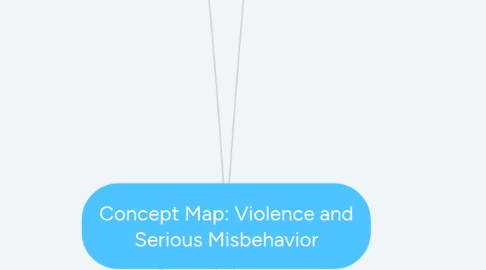
1. Academic Dishonesty
1.1. Causes:
1.1.1. Fear of failure
1.1.2. Students do not perceive the relevance of school tasks
1.1.3. Students see tests and assignments as rituals instead of an indication of knowledge
1.2. Prevention
1.2.1. Eliminate trick questions or "distracter" questions on tests and assignments
1.2.2. More frequent testing and assignments can help reduce pressure to cheat
1.2.3. Resort to private correction instead of public correction for instances of cheating
2. Vandalism
2.1. Graffiti
2.2. General property destruction
2.3. Break-ins
2.3.1. Nuisance Break-ins
2.3.1.1. The act of breaking in is the only purpose. Usually done as a prank, or to elicit excitement
2.3.2. Malicious Break-ins
2.3.2.1. Committed by individuals who seek to destroy property
2.3.3. Professional Break-ins
2.3.3.1. Intent is for individuals to steal property
2.4. Causes:
2.4.1. Possibly a product of modern society that is characterized by alienation and meaninglessness
2.4.2. Feelings or margnialization
2.4.3. No sense of belonging
2.4.4. Poor understanding of the impact of their actions
2.4.5. No sense of ownership
2.4.6. Poor understanding of the impact of their actions
2.5. Solutions:
2.5.1. Better school climates - personal, responsive, participatory, hands-on approach, etc.
2.5.2. Better student/teacher relationships - mutual levels of respect, understanding, connection, and discipline
2.5.3. Address the students academic needs to prevent fear of failure
2.5.4. Build sense of ownership by educating students on how funds are distributed through the school for their benefit
2.5.5. Implementation of natural and logical consequences not centered on punishment
3. Substance Abuse
3.1. Causes:
3.1.1. Peer influence
3.1.2. Rebellion
3.1.3. Attempt to be more mature
3.1.4. Low self-esteem, lack of confidence, or perceived incompetence in dealing with reailty
3.1.5. School failure
3.1.6. Attempt to be more mature
3.2. Solutions:
3.2.1. Zero-Tolerance
3.2.1.1. Not completely effective in addressing availability of drugs
3.2.2. School initiated programs such as D.A.R.E.
3.2.2.1. Programs don't address factors like depression, low self-esteem, anxiety, learning disabilities, etc.
3.2.3. Effective programs need to have the active engagement of the community
3.2.4. Prevention should focus on:
3.2.4.1. Academic success
3.2.4.2. Social skills
3.2.4.3. Self-control
3.2.4.4. Drug refusal skills
3.2.5. Help students feel significant, provide them with success, and create positive open environments
4. School Violence
4.1. Becoming more prevelant due to:
4.1.1. Bad home envrionments
4.1.2. Poverty
4.1.3. Exposure to violence in media
4.1.4. Social/emotional/mental issues
4.2. Growing importance for teachers to recognize indicators of violence:
4.2.1. Past history of violent or bullying behaviors
4.2.2. Victim of abuse or neglect
4.2.3. Bad home environments
4.2.4. Recent experiences of loss or rejection
4.2.5. Gang affiliation
4.2.6. Mental illness
4.2.7. Social withdrawal
4.3. Schools face issues with addressing violence:
4.3.1. Punishment programs evoke fear
4.3.2. Zero-Tolerance policies are ineffective and lack common sense
4.3.3. Security measures are not 100% effective
4.4. Emphasis on violence prevention through three types:
4.4.1. Primary - development of prosocial attitudes and behaviors
4.4.2. Secondary - early screening and identification of at-risk students
4.4.3. Tertiary - focus is on students who have engaged in violent behavior
4.5. Violence Against Students
4.5.1. An engaged and connected classroom can help reduce this
4.5.1.1. Stopping Aggression Before it Escalates
4.5.1.1.1. 1. Eliminate audience
4.5.1.1.2. 2. Use calm talking to bring down tension
4.5.1.1.3. 3. Is situation is still tense, use assertive but firm approach
4.5.1.1.4. 4. Allow students to calm down, then talk individually
4.5.1.2. Respond to Fighting
4.5.1.2.1. 1. Assess the situation
4.5.1.2.2. 2. Move in, disperse audience, give firm verbal commands.
4.5.1.2.3. 3. Stay alert, keep hands up for quick reactions and protection.
4.5.1.2.4. 4. Task is not over just because the fighting has stopped
4.5.1.2.5. 5. Document the incident
4.5.2. DEFUSE Tense Situations
4.5.2.1. D - Depersonalize and don't lose your cool
4.5.2.2. E - Encourage the students to vent, and empathize with them
4.5.2.3. F - Find out the facts
4.5.2.4. U - Understand their feelings
4.5.2.5. S - Suspend your ego
4.5.2.6. E - End on a positive note
4.6. Violence Against Teachers
4.6.1. Possible Causes:
4.6.1.1. Result of power struggle
4.6.1.2. Disdain for authority
4.6.2. Prevention Techniques:
4.6.2.1. Teachers should not engage arguments intended to get a rise out of the teacher
4.6.2.2. Do not engage situations which may become hostile with your presence
4.6.2.3. Follow mandated procedures and guildelines
4.6.2.4. Identify, and attempt to create meaningful connections with at-risk students
5. Truancy and Attendance Problems
5.1. Can be an early warning sign of delinquency, substance abuse, school failure, or dropping out.
5.2. Causes:
5.2.1. Family Factors
5.2.1.1. Homelessness
5.2.1.2. Poverty
5.2.1.3. Family conflict
5.2.1.4. Negative family/school relationship
5.2.2. School Factors
5.2.2.1. Feeling unwelcome
5.2.2.2. Not fitting in
5.2.2.3. Boredom
5.2.2.4. Falling behind in schoolwork
5.2.2.5. Negative perceptions of school
5.2.2.6. Inappropriate placement, putting success out of reach
5.2.3. Personal Factors
5.2.3.1. Low self-esteem
5.2.3.2. Academic failure
5.2.3.3. Feelings of rejection by parents
5.2.3.4. Poor relationships with peers
5.2.3.5. Gang involement
5.3. Solutions:
5.3.1. Family Factors
5.3.1.1. Teachers can address negative family relationships with the school by improving the contact with parents.
5.3.2. School Factors
5.3.2.1. Teachers can make sure that students are appropriately placed
5.3.2.2. Provide frequent positive encouragement to build students confidence in their academic abilities
5.3.3. Personal Factors
5.3.3.1. Help build students self-esteem by building meaningful relationships and encouraging peer relationship development through group/team work
